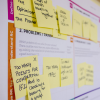Many successful brands have adopted design thinking in full or in parts, from conglomerates like IBM and Nike to smaller players like Slack. The benefits are obvious. It puts you closer to the customer, reduces bias and untested assumptions, breaks down silos, and spurs innovation.
But it took years for these companies to transform. Intuit took close to a decade to become a design driven company it is today. And while smaller companies have an advantage in size, it still requires a lot of convincing before management would agree.
For a product designer, UI or UX expert, the design thinking principles are gold. If your office hasn’t warmed up to this kind of mindset, you can still apply the principles in your role. This also works if you’re in a non-designer role, such as marketing or HR, because design thinking works for any job that requires a little creativity.
Practising design thinking will make you better at your job, shape you into a more valuable team player and, at the very least, allow some excitement and wonderment into your mundane 9-5 routine. Because design thinking is about being a beginner again, embracing playfulness and curiosity while constantly testing your ideas.
So, how do you begin? These 6 principles will, hopefully, give you more satisfaction out of work.
1. Always observe things
Instead of letting your mind wander throughout the day, spend a few minutes to really observe the things and people around you. It could be a customer waiting in the help desk area, a colleague planning out the roster, how people unbox your product or even how the files are organised at work.
Once you make it a habit to notice things and people, patterns will start to emerge. You’ll find loopholes, unnecessary steps, irrelevant rules, and a lot of things that don’t make sense or make it harder for people. It’ll soon become obvious that some problems are seriously dragging down your product or workplace.
2. Immerse yourself in an experience
One of the pillars of design thinking is empathy. You have to put yourself in the users’ shoes. Once you’ve identified a problem worth solving, try immersing yourself in the full experience. This helps you deep dive into the problem, seeing and feeling what the user does.
If you’re investigating why customers keep filing for refunds, order a few products and observe whether what was promised is what you get. If you’re wondering why many colleagues are complaining about the slow IT service, file a few issues yourself.
Don’t stop there. Get a few friends and colleagues to try it out too, if possible, and get their feedback. Because their perspective, behaviour and reaction will be different to yours. You’ll need to gather as many inputs as you can to gain a holistic look at the issue.
3. Challenge current assumptions
Sometimes, you need to challenge the conventional wisdom and the way things work. This is the crux of design thinking. Just because something is working, doesn’t mean it is working right or at its best.
You’ll need to reframe the problem to help you understand what the issue really is. Ask questions no one has thought of asking before. It’s easier to do this if you have immersed yourself in a problem and spoken to different people.
Maybe you’ll discover that the issue isn’t the product but the process itself, or vice versa. Or maybe you’ll realise that the team failed to understand human behaviour under certain circumstances. Either way, challenging the status quo will help generate a bunch of ideas.
4. Involve other people
Design thinking emphasises working together instead of in silos. The simplest thing you could do is to start talking to people you wouldn’t normally chat to at work. At times, the best ideas can come from people who aren’t part of the process and project or who don’t use the product at all. Your simple regular chats can turn into brainstorming sessions or new proposals, opening new doors for you at work and your career.
5. Do small incremental tests
Iterative testing is another component of design thinking. If you’re considering a radical transformation, try breaking it down into small measurable adjustments. Testing small changes will give you a better idea on the next steps to take. Based on the user feedback, you can continue improving it until it is ready for production.
Furthermore, people are often nervous about big changes. If you’re trying to persuade management or the rest of the team to back up your idea, it’s much easier when you do it piece by piece and have solid data to back it up. And if you make a mistake, it’s easier and faster to correct it.
6. It’s perfectly okay to fail
Finally, it’s okay to fail. This is perhaps the most important takeaway of the design thinking approach. Failures give you clear signals towards the path to success. It’s okay if your idea is bad, or you bit off more risk than you could chew. If you’re not making the same mistakes, you’re fine. Embrace trying and failing.
I know some companies don’t tolerate failure as well as others, so you’ll have to be smart about it. If you feel that work is stifling you from growing, then it’s time to plan for the exit. Find a place that values your curiosity and enthusiasm because, really, the world needs it.







